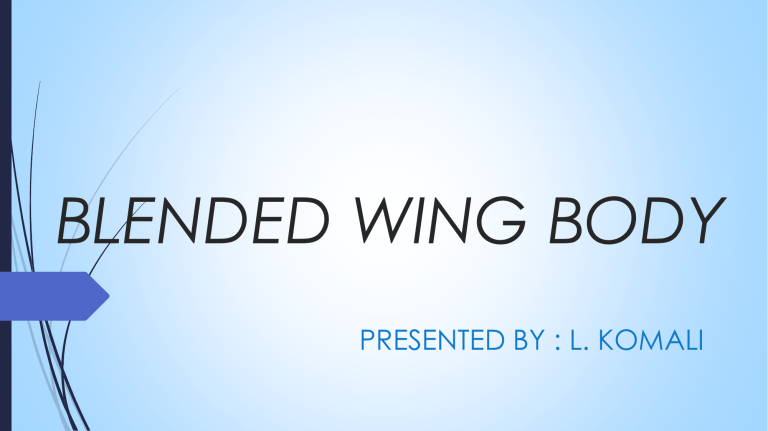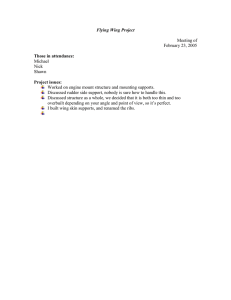
BLENDED WING BODY PRESENTED BY : L. KOMALI CONTENT 1. INTRODUCTION 2. BRIEF HISTORY OF BWB 3. COMPARISON BETWEEN CONVENTIONAL PLANE AND BWB PLANE 4. DESIGN AND STRUCTURE OF BWB 5. FEATURES OF BWB PLANE 6. ADVANTAGES AND DISADVANTAGES OF BWB 7. CONCLUSION INTRODUCTION Blended wing body (BWB) aircraft have a flattened and airfoil shaped body, which produces most of the lift, the wings contributing the balance. A BWB aircraft is a configuration where the wing and the fuselage are integrated which essentially results in large flying wing. Theoretically it can carry up to 800 passengers at a mach number of 0.85. Blended wing body has lift to drag ratio 50% greater than the conventional airplanes. The advantage of the BWB approach are efficient high lift wings and a wide airfoil shaped body. This enables the entire aircraft to contribute to lift generation with the result of potentially increased fuel economy and range. In the conventional aircraft, the wing is generating the major part of the lift, whereas in BWB in addition to the wing, the fuselage is also contributing in the generation of lift, thus increasing the lifting surface area. The streamlined shape between fuselage and wing intersections reduces interference drag, reduces the wetted surface area that reduces friction drag. Since there is a slow evolution of fuselage-to-wing thickness which creates the wing root area comparatively thick which can be used for payload and fuel capacity. The BWB concept aims at combining the advantages of a flying wing with the loading capabilities of a conventional airliner by creating a wide body in the center of the wing to allow space for passengers and cargo. Especially, for very large transport aircraft, the BWB concept is often claimed to be superior compared to conventional configurations in terms of higher lift-to-drag ratio and consequently less fuel consumption. BRIEF HISTORY OF BWB • The concept of blended wing body was introduced almost 27 years ago. • The idea was to build a new type of aircraft that would allow the aircraft to carry more passengers. • BWB aircraft was previously called as “tailless airplane” and “flying wing aircraft”. Comparison Between Conventional Plane & BWB Aircraft • Centre body of BWB structure is used as passenger cabin as well as wing also, so it must carry the pressure load bending as well as wing bending load. • In conventional aircraft, the wing is only the main contributor for generation of lift whereas in BWB aircraft fuselage generate lift together with the wing. Features Of BWB Design a)The BWB is a tailless aircraft: Because of the disc-shaped nature of the fuselage, the BWB does not have a tail. As a result, the BWB does not have a rudder. b)The engine location of the BWB: Engines of BWB aircraft are located at the aft sections of the plane. Because of the weight and balance considerations of the plane, the engines needed to be placed at the rear of the plane. Additionally, with the engines at the rear of the plane, the fuselage can serve as an inlet for intake of air. c)Control surfaces: The control surfaces of the wing are located along the leading and trailing edges of the wing and on the winglets. The number of control surfaces can vary from 14 to 20 depending on the BWB design. d)The BWB is a windowless aircraft. Propulsion • Installing the engine on aft location for BWB design offers the opportunity for ingestion of boundary layer generated on centre body which is forward of engine inlets. • In principle, ram drag is reduced by boundary-layer-ingestion & thus improving the propulsive efficiency. • Other advantages of aft engine location include foreign object damage, noise, reverse thrust, emergency egress, ditching, and maintainability. Structure • Centre body of BWB structure is a unique element. As functioning as passenger cabin, it has to carry pressure load in bending, and as it is also acting as lifting body (wing), it must carry the wing bending load. • The primary challenge was to develop a structural concept for centre body which can carry the cabin pressure load. • The passenger cabin of BWB configuration has to experience its design pressure load on every flight unlike the passenger cabin of conventional aircraft which rarely experiences its design load. • Thus considering the fatigue failure as a critical case for passenger cabin, centre body should be built using composite materials due to their comparative immunity to fatigue Stability & Control • The trailing edge control surfaces, which are hinged on the outer wing, functions as elevons. The elevons which are on the outer surface of the wing are primarily pitch and roll control due to largest lever arm about the centre of gravity. • The rudders which is installed on the winglets provide primary directional stability and control. For the engine out condition at low speed, the outboard elevons become split drag rudders • Both rudders would be deflected to opposite sides to cancel out each other’s yaw moments and their drag will act as an air brake. ADVANTAGES • Increased in the passengers capacity up to 800 • Reduction in the fuel consumption of the aircraft (burns 27% lesser fuel ) • High L/D ratio due to a decreased relative wetted area ( area which is in contact with the external airflow) • Favourable load distribution along the span • Possible engine noise shielding • Lower production cost • Reduced airport/airspace congestion • Improve safety DISADVANTAGES • Because of the aircrafts shape , the seating layout would be theatre style instead of tabular. This imposes inhererent limits on exit doors. • As engines are placed above the rear fuselage ,air safety authorities have expressed concern that in an accident they could become detached and their momentum carry them forwords so that they fall onto passenger cabin. • As there will be no windows, people will feel air sickness. • The last issue was how do you handle 800 passengers as several terminals are not designed to handle that the volume of humanity. CONCLUSION • • • • • • • The BWB is fuel efficient Less materials required to produce the body Less complicated design Less noise High lift to drag ratio Carry more passengers Less pollutant THANK YOU





